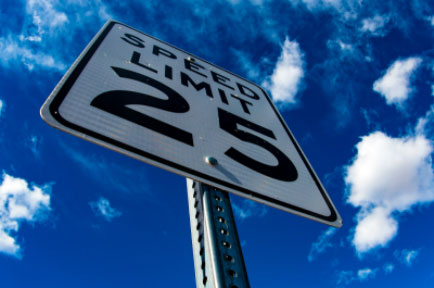Safe Driving Tips That Can Lower Your Insurance Premiums
Do we always do what’s good for us, like eating right, getting plenty of exercise, following a budget, or driving safely?
Not exactly. We’re all guilty of indulging in that third birthday cake of the week at the office, foregoing a walk because it’s raining and we’re itching to binge-watch The Crown, impulse-buying a fabulous new outfit, and checking a text we’ve been waiting for while behind the wheel.

We want to help motivate you regarding driving safely by sharing how safe drivers can save on car insurance. There are a variety of ways to lower your rate, from actions you can take on your own to tech assists from apps and even insurance companies themselves.
As a woman, you may think you’re already saving on car insurance if you’ve heard that females pay less than males. But that’s only accurate during the teen years, as insurers consider adolescent males the least-safest drivers. The difference of about $300 a month decreases greatly, especially after age 25, to a negligible $15 a month.
Given that, along with the gender pay gap around 80%, and average wages not keeping up with economic growth or rising inflation, it’s a perfect time to look at how to save on your rate.
Practice Car Care and Self-Care to Be a Safer Driver
While car insurance doesn’t cover the cost of regular maintenance to your vehicle, being proactive about checking that item off of your to-do list can help keep your premium from rising — and even make you eligible for certain discounts.
Car Care Tips for Safer Driving
Neglecting your vehicle’s routine maintenance can easily result in unsafe driving. And the consequences — from causing an accident to receiving a traffic violation — can hike your insurance. Poorly maintained vehicles are one of the leading causes of car crashes.
A few hundred dollars a year or less for regular maintenance can help save you thousands long-term, as blemishes on your driving record can stay there for three to five years, and you’ll be charged a higher premium that entire time.
Taking care of your car means more than taking it to your mechanic or your dealer for an annual inspection. There are several items you should regularly monitor. Act as soon as you can when you spot wear and tear or a problem, even if it’s before conventional wisdom advises replacement. If it’s something you can’t take care of yourself, don’t delay in seeking a professional.
A weekly walk-around of your vehicle is a great idea, especially if you have a daily commute. You don’t necessarily have to check the pressure of all of your tires or the levels of all of your fluids every week. But at least a visual inspection can catch deflated tires or problems with headlights or taillights.
In addition to the annual inspection and your walk-around, keep your visibility optimized by keeping your car windows clean and by replacing your windshield wipers every six months to a year.
And don’t forget to keep your gas task at least a quarter full. You don’t want to risk your car being hit when it stalls, as even if you have the option to pull onto the side of the road, your car is still at risk of being hit. An empty gas tank can also damage your car, leading to the possibility of an accident down the road.
Self-Care Tips for Safer Driving
Neglecting your own personal maintenance can also result in unsafe driving.
Reduce the Potential of Drowsy Driving
Adopting healthy sleeping habits will help improve your focus, which will make you a better driver. You may be unfamiliar with the term “drowsy driver” since it doesn’t receive as much attention as drunk driving, but it’s just as dangerous.
The National Highway Traffic Safety Administration (NHTSA) estimates drowsy driving caused 91,000 police-reported crashes in 2017, resulting in 50,000 injuries and nearly 800 fatalities.
In addition to getting a good night’s sleep, here are a few other tips to combat drowsy driving:
- Steer clear of alcohol before driving, since it increases drowsiness and impairment.
- Check the label on any medication before you take it to see if it could cause drowsiness.
- Take regular breaks to get out of that seated position and stretch your legs.
- Avoid driving from midnight to 6 a.m. as well as late afternoons, as these are considered peak sleepiness periods.
- Employ short-term fixes including opening a window or turning on the air conditioning to keep the car cool, turning up the music, drinking a caffeinated beverage, or pulling over for a catnap.

Apply Anger Management While Driving
If you go to bed angry, you’ll intensify your anger. The same adage applies if you get behind the wheel angry. You’ll be much more inclined to indulge in road rage, making you an unsafe driver who tailgates, pushes that accelerator too hard, or lashes out at another driver — all of which could cause an accident and raise your car insurance rate.
The NHTSA found that aggressive driving is the cause of 66% of traffic fatalities, leading to 218 murders and 12,610 injuries over a seven-year period.
Tips to help avoid aggressive driving include:
- Always allow for extra travel time. Factor in weather and typical traffic as well as events that could increase traffic, and plan alternate routes.
- Drive courteously and obey traffic signs and signals. This will not only help keep you calm but also help you from irking other drivers and potentially igniting their road rage.
- Take deep breaths and don’t allow yourself to get angered. You can’t control other drivers, but you can control your reactions to them.
Practice Self-Restraint to Be a Safer Driver
Distracted driving is more rampant than ever. One of the leading causes? Not surprisingly, cellphones. Their use while driving is not only hazardous, but in many cases, it’s also illegal. And it can lead to spikes in your car insurance.
Out of sight, out of mind is the best way to avoid using your cellphone. But that’s not feasible for everyone. Ironically, technology can come to your rescue. Look into apps and tools that set limits and notifications on your phone when you’re driving.
But cellphones aren’t the only thing tempting us to take our eyes off the road. The basic rule is: Don’t multitask when you’re behind the wheel, including eating or even reaching for something that has fallen. If you really need to take care of an additional task, pull over.
How Insurance Can Help You Drive Safer
Yes, insurance is a for-profit business. But part of increasing profits is reducing risks. And if insurance companies can reward their customers to reduce the risk of accidents from unsafe driving, that’s less they have to pay out in claims.
So car insurance carriers employ a continually evolving variety of ways to help you focus on being a safer driver.
Insurance Discounts for Safe Drivers
The cleaner your driving record and the longer your record stays that way, the better you can lower your car insurance rate thanks to discounts.
Most of the major carriers have more than one type of safe-driving-related discount — such as for a safe driver, for taking a defensive driving course, or for being accident-free. Each insurance carrier is different, so ask your existing insurer what they offer, and do the same whenever you’re comparison-shopping your car insurance.
For example, one of the largest car insurance companies, Allstate, has enhanced its Allstate Driving Safe Driving Bonus with the Allstate Safe Driving Bonus Check. This is for policyholders who are part of the Allstate Your Choice Auto Program, eligible to customers who have a clean driving record and good credit.
The Safe Driving Bonus rewards credit to customers who don’t have a claim within a specified policy term, usually six months. The credit is up to 5% of your premium, which is applied to your renewal policy. The Bonus Check enhancement allows you to receive that credit as a check sent to you for the amount you earned for being a safe driver, and it’s yours regardless of whether you renew.
Usage-Based Insurance for Safe Drivers
Customizing your insurance can help you lower your premiums. Insurance companies have taken advantage of vehicle tracking devices — via embedded in the vehicle, a mobile app, or a plug-in — to create usage-based insurance (UBI).
Besides pay-per-mile car insurance, which calculates your premium based on how much you drive, there’s also pay-how-you-drive insurance. This monitors your driving patterns, including your acceleration, braking, and speed.
The savings you can achieve with UBI is even higher than with insurance discounts. Savings with the major car insurance companies include:
- Up to 15% with Allstate (DriveWise) and Farmers (Signal)
- Up to 20% with American Family (KnowYourDrive), Geico (DriveEasy), Progressive (Snapshot), Travelers (IntelliDrive), and USAA (SafePilot)
- Up to 25% with Esurance (DriveSense)
- Up to 30% with Liberty Mutual (RightTrack) and State Farm (Drive Safe and Save)
- Up to 40% with Nationwide (SmartRide).
With those percentages, you can see why UBI is gaining in popularity.
We hope we’ve raised your awareness of the many avenues you can take to lower your car insurance payment. And don’t forget an additional benefit of driving safely: You’re setting a great example for your children, which could save you money on car insurance for them if they put into practice what they’ve learned from you.
 Karen Condor writes for the insurance comparison site, TheTruthAboutInsurance.com. Being a mindful driver and remaining accident-free has helped save her hundreds of dollars a year on car insurance.
Karen Condor writes for the insurance comparison site, TheTruthAboutInsurance.com. Being a mindful driver and remaining accident-free has helped save her hundreds of dollars a year on car insurance.


